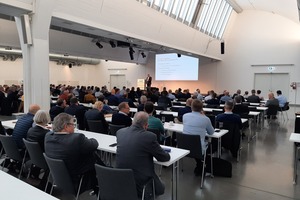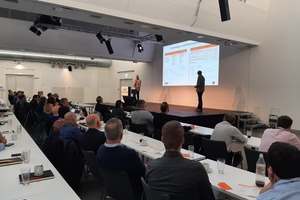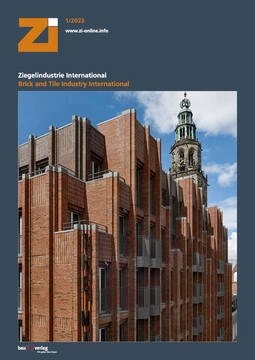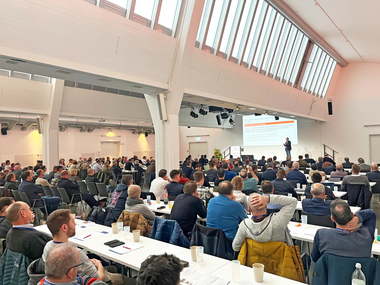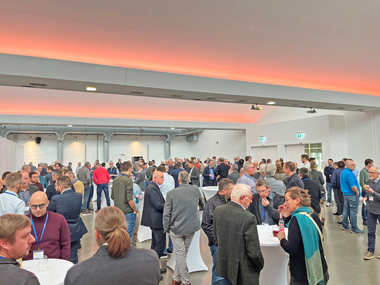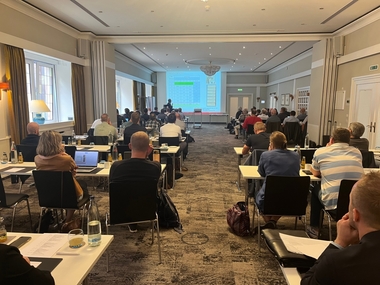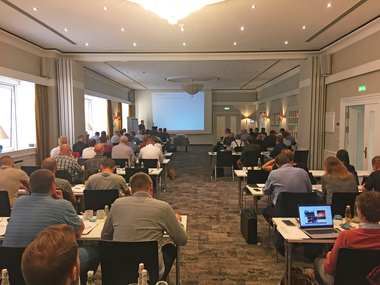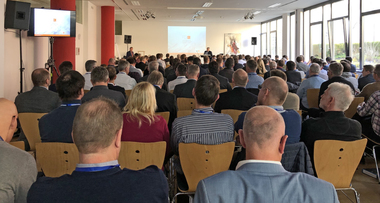Full house and full success after a two-year break
The joy of reunion was written all over the faces of the participants. After a two-year hiatus, the Würzburg brickmaking course could take place again. More than 200 industry experts from manufacturers and suppliers came together on 29 and 30 November 2022. In view of the surprisingly large number of registrations, the course was not held at the Landesgewerbeanstalt (LGA) but was moved to a specially rented event hall in Würzburg. In order to make the brick course as safe as possible considering the still virulent Corona virus, the programme was streamlined from the traditional three to two days and the excursion was omitted.
Lectures of the first day
David Ostendorf, Technical Managing Director of the Federal Association of the German Brick and Tile Industry, welcomed the participants to the course. Opening the lecture programme, he spoke about the current challenges of the brick industry in Germany. According to Ostendorf, the solution lies in consistently continuing the research efforts of the entire industry in order to be able to successfully counter energy shortages and cost increases.
Katharina Armbrecht, Head of Energy and Environment at BVZi, addressed the energy and climate policy challenges facing the brick and tile industry in her presentation. She also provided information on the current status of planned political measures such as the gas and electricity price brake.
Silbe Sabath from the Institut für Ziegelforschung e. v. in Essen gave the audience an overview of the existing subsidy programmes. The main focus of the lecture was the detailed presentation of the newly launched funding programme of the Federal Office of Economics and Export Control “Federal funding for energy and resource efficiency in the economy”.
Anne Giese from the Gas- und Wärmeinstitut Essen e. V. discussed the possible use of hydrogen as a fuel of the future. Green hydrogen offers potential for the environmentally friendly provision of process heat. There are still challenges in controlling the changes in flame temperature and NOx emissions. The central challenge is to make hydrogen available on an industrial scale. The use of ammonia as a chemical storage for hydrogen or even as a fuel can be a solution.
Torsten Bärtels from the company Keller HCW GmbH described in his presentation “Climate-neutral firing process in the brick industry - feasible for us?” his company’s previous experience with various technical paths to achieve climate-neutral brick production. In detail, he discussed a current hydrogen research project in North Rhine-Westphalia, the experiences made so far with electrification and the assessments derived from them, as well as approaches to increasing the energy efficiency of the tunnel kiln and the dryer-furnace network.
Christoph Brune from Innovatherm Prof. Dr. Leisegang Gmbh + Co. KG outlined the challenges of clean gas combustion technology and the experience gained and solutions found. Reducing the amount of air used in the kiln reduces the amount of heat required, thus saving fuel and emissions. To maintain convection and avoid local overheating and reduction effects, a new burner concept was developed. Firing in pulses of different lengths can influence the quality and efficiency of the kiln firing.
Jens Petzold, head of the KI Ceramics Institute in Meißen, reported on the experiences made at the institute with test firings in a chamber kiln operated with hydrogen and in an electrically operated tunnel kiln. In the case of hydrogen, the lecture focused on the influence of the water vapour partial pressure on the formation of the body and glaze. A reduction of the water vapour partial pressure can lead to a reduction of energy consumption in muffled electrically operated single-layer tunnel kilns.
Herbert Grünbichler from Cress presented a furnace interior coating with high emissivity. Based on the properties of emissivity and reflectivity, the functionality of the coating was explained. Emisshield is intended to reduce heat losses in the oven and extend its service life. A list of references was used to illustrate the energy-saving potential.
In the last lecture of the first day, Lucas Briest from Otto von Guericke University in Magdeburg discussed the possibility of efficient brick drying using a combination of intermittent microwave and convection. From the presented test results, it emerges that an intermittent energy input equalises temperature profiles and reduces the total energy consumption. The efficiency level is between 62 and 80 percent. The efficiency depends on the material properties and the water loading. Additional heating with hot air, on the other hand, proves to be disproportionate.
At the end of the first day of the course, participants, lecturers and organisers met for a joint dinner and exchange at the Würzburger Hofbräu.
Lectures on the second day
The second day of the course was introduced by Dr. Lutz Krakow of Dr. Krakow Rohstoffe with an overview of 10 new raw material concepts for the brick industry. Potentials for sustainable clay extraction outside clay pits exist, for example, in mineral washing, tunnel excavation, the deconstruction of sludge ponds or the use of modern filter presses. Results of studies on the suitability of alternative raw materials obtained in this way for brick production were also presented.
This was followed by an introduction into clay mineralogy for brickmakers. Kathrin Müller explained the basic tetrahedral and octahedral structures of clay minerals in her lecture. On this basis, various groups of clay minerals were then recorded and described in terms of their chemical and structural properties: Kaolin-Serpentine, Pyrophyllite-Talc, Mica, Smectite and Chlorite.
Matthias Daut, Sales Manager at VHV Anlagenbau GmbH in Münsterland, used a case study to present how VHV modernises a clay transport plant. The case study dealt with the replacement of a shingle belt with a cover belt conveyor. Daut also presented VHV’s services, such as taking measurements with a 3D scanner and visualisation in the CAD system, and products such as the rolling mill inlet bonnet and the rolling mill outlet chute.
Wilbert Jochims from Imerys Kiln Furniture announced an innovation for roof tile firing. He presented the T-shaped cassette developed and patented by his company. This, in contrast to the classic H-shaped cassette, is designed to prevent chipping on the roof tiles.
Mario Hollmann from Refratechnik Ceramics GmbH discussed the balancing act between energy efficiency and durability. He presented among other things various kiln car systems from Refratechnik that take this conflict of objectives into account. Lightweight materials reduce energy consumption, stable geometries ensure a long service life. Increases in energy efficiency are possible with the Refratherm Eco bulk material, he said.
Michael Seitzer from Lingl Anlagenbau presented an automatic wall section laying system for facing bricks. The system can install three different types of brick slips (colours, thicknesses, sizes) on different substrates. The output is supposed to be 2,000 mounted facing bricks per hour. The possible arrangements of the bricks are wild bond, half brick bond and block bond.
Following the lunch break, Ulrich Hagemann from Keller HCW GmbH discussed in his presentation of the same title the thesis of whether efficient industrially prefabricated brick walls are a modern high-tech product. In his lecture, he presented various precast walls made of bricks and other building materials and discussed the advantages of prefabrication. He then presented the production plant developed by Keller for manufacturing prefabricated wall elements. Digressively he also discussed the Hadrian X construction robot in Australia and 3D house printing using the house in Beckum as an example.
Horst Heffter from Cermyc Heffter Consult presented a wear-resistant system for press screws from the Italian company Latermec. It is a treatment solution for press screws. It combines wear-resistant tungsten and chromium carbide welding with a hard-chromium plated surface. This combination balances the respective disadvantages of both processes, reduces energy consumption and the number of maintenance intervals.
Alexander Freyburg from the Materials Research and Testing Institute at the Bauhaus University Weimar discussed the question of whether a circular economy is more of an opportunity or an obstacle for the brick industry. In addition, he presented current research topics that can contribute to the establishment of a circular economy of bricks, such as the construction of buildings from bricks that can be separated by type in the future.
Alexander Winkel from the Institute for Brick Research in Essen discussed the influence of mineral additives on the drying behaviour and product properties of bricks. Presented test results show that a targeted increase of the packing density improves the drying behaviour. The flexural strength of the dried and fired products is reduced, sometimes considerably. The suitability of an additive has to be tested for each individual case, as the reaction with the clay cannot be predicted.
Lukas Helm from the Technical University of Kaiserlautern and Lars Etscheid (IZF) gave a presentation on the state of research on the out-of-plane load-bearing capacity of brick masonry in earthquakes. They presented an engineering model for calculating the out-of-plane load-bearing capacity, focussing on the consideration of the vertical stiffness at the upper support. This has been identified as a significant factor and has not been considered with sufficient accuracy in any known model to date. With the help of the model, slender, non-load-bearing and particularly susceptible interior walls are examined, among other things on a three-axial vibration test stand of the Chair of Design in Mechanical and Automotive Engineering.
Valentin Heizinger from Leipfinger Bader discussed the current state of brick recycling. Using his company as an example, he explained how recycling works on a company scale and what advantages it brings. As a recycled building material of the future, he presented the cold brick, which can be produced from various material flows from production, recycling and demolition. The next step is to clarify plants and market potentials for large-scale production. Brick recycling is thus proving to be the basis for numerous product innovations.
Fire resistance of thermally insulating brick masonry was the focus of the last lecture of the course. Heiner Kruse (TUK) discussed the criteria for classifying a building component: Time, space closure, thermal insulation and mechanical stability. A current research project for the classification of thermally insulating vertically perforated bricks was presented. This also includes the definition of an extended scope of application of the table values for the classification.
Conclusion and outlook
Looking back, the organisers of the LGA, Dagmar Schädel and Joachim Deppisch, were very satisfied. They considered the event a success, the new conference venue had been well received. The joy of meeting again after two years was also clearly noticeable among the participants. The course well-received throughout.
Schädel and Deppisch as well as the other organisers hope that the Würzburg brickmaking course can be held again in its usual and proven form from 2023.

